The Wonders of the Basilique Saint-Denis


Even people who have been to most of the monuments in Paris have often not visited the city’s “other” cathedral, the Basilique Saint-Denis. That is strange, because it pre-dates Notre-Dame de Paris by some 25 years and, being the last resting place of nearly every French monarch, it is a repository of French history second to none. Almost all of the 42 kings and 32 queens buried here have their own marble effigy, many of them works of poignant beauty.

Earliest sarcophogi in the crypt. @ CC BY 2.0
It is also a splendid and uplifting building. Whether you go in search of the spiritual, or are seeking to piece together centuries of French history, surely what you will notice first is the soaring beauty of its interior. St Denis was the first gothic cathedral in France, built under the supervision of Abbé Suger in the 12th century and his vision of a space full of light and color has been majestically realized. It should, he said, be “une dentelle de pierres et de verres,” a lacework of stone and glass and, incredibly, the builders and craftsmen of over 900 years ago achieved just that. The combined effect of the slender pillars, the delicate stonework and the huge, luminous stained-glass windows is simply stunning.
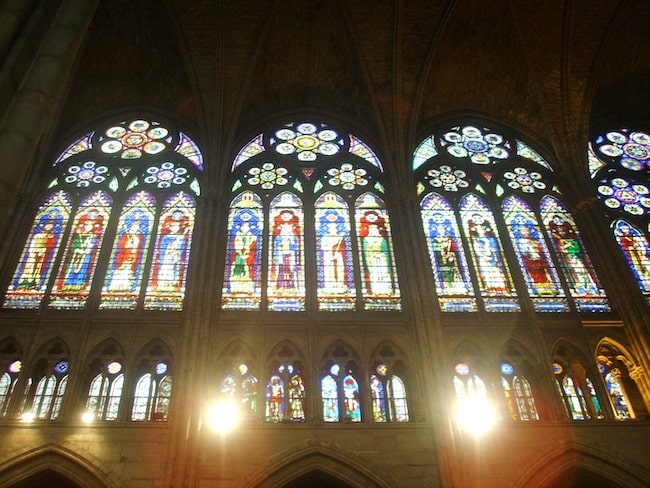
The glazed triforium. @ CC BY 2.5
The site was important to French Christians long before the 12th century, because of its links to the martyr Saint Denis, whose story is one of France’s most familiar legends. Having reached the age of 100 or so, converted many to Christianity and founded a number of churches, he was challenged by enemies in the year 261. He is said to have survived beatings, being fed to lions and a crucifixion before they beheaded him. At that point, the story goes, he stood up, picked up his head and walked with it for several miles until he collapsed and died. On that exact spot was built the first church in his name and because of his fame as a martyr it was seen straightaway as a fitting place to bury royalty.

Saint Denis of Paris. @ CC BY-SA 3.0
To wander among the tombs and statues honoring France’s kings and queens and read their picturesque names is to become aware of centuries past. There lie Pépin le Bref, Philippe le Hardi, Berthe au grand pied and such romantically-named queens from long ago as Isabelle d’Aragon and Béatrice de Bourbon. Most unforgettable of all is the tiny marble effigy of Jean le Posthume, who died at five days old in November 1316. Because his father had pre-deceased him, little Jean was born a king, only to be buried immediately at his father’s feet, a poignant reminder of the harshness of existence in the 14th century.
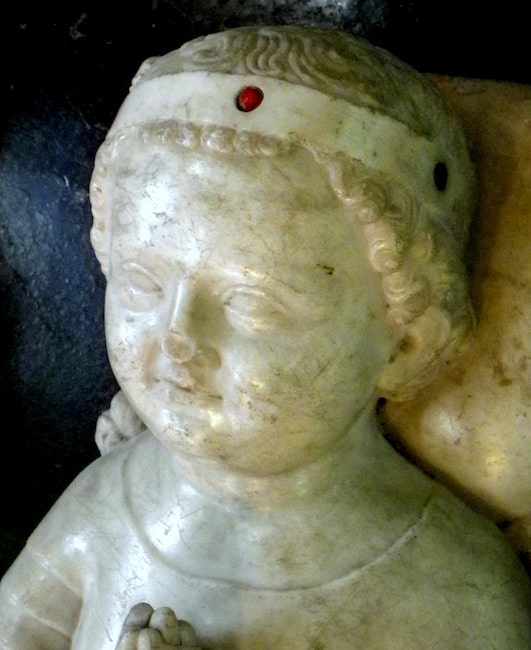
Jean Ier le Posthume. @ CC BY-SA 4.0
If you know a little history, it is easy to imagine some of the scenes which took place at St Denis. In 1389 Charles VI summoned his newest knights to pledge their allegiance to him here and a grand celebration was held. Between the dubbing ceremony, and the final grand mass came a banquet, a ball and three days of tournaments and jousting. Another splendid occasion occurred after the coronation of François I. That took place at Reims in 1515, but for his entry into Paris a stop was made at Saint Denis, so that an ostentatious escort could be arranged for the last few miles.
At the head of the procession were the king’s household men, dressed in silver and gold and sporting royal insignia, followed by musicians and heralds, then the king himself, astride his horse and throwing gold and silver coins to his subjects as he passed. Behind him, further underlining his splendor and majesty, marched 200 troops and 400 archers.
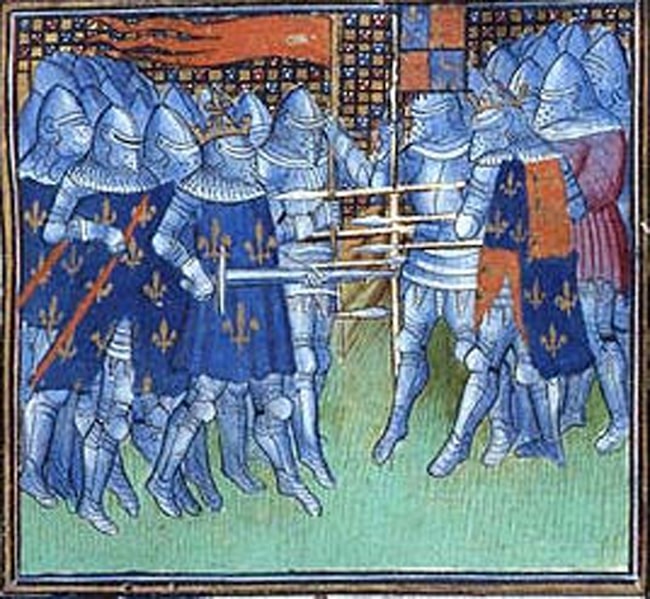
Battle of Poitiers. @ Public Domain
Perhaps nowhere in France are religion and politics so intertwined. It was here in July 1593 that the Huguenot Henri de Navarre, the future Henri IV, renounced his protestant faith, to make himself a more acceptable king to the catholic majority. This pragmatism has come down the centuries in a remark attributed to him: “Paris is worth a mass.”
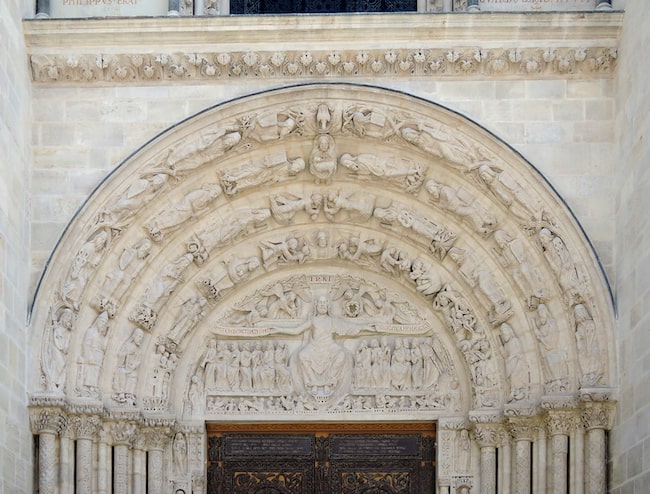
Tympanum and lintel of the central portal. @ CC BY-SA 4.0
The cathedral was desecrated during the Revolution, its roof torn off and melted down, but when Napoleon came to power he was quick to spot its potential to help him cement himself into the long tradition of the rulers of France. He had three chapels built and declared Saint Denis to be the chosen burial place for himself and his descendants. History denied him, and when the French monarchy was restored in 1814, the ashes of the executed Louis XVI were retrieved from the communal grave into which they had been flung and reinterred here with due ceremony.
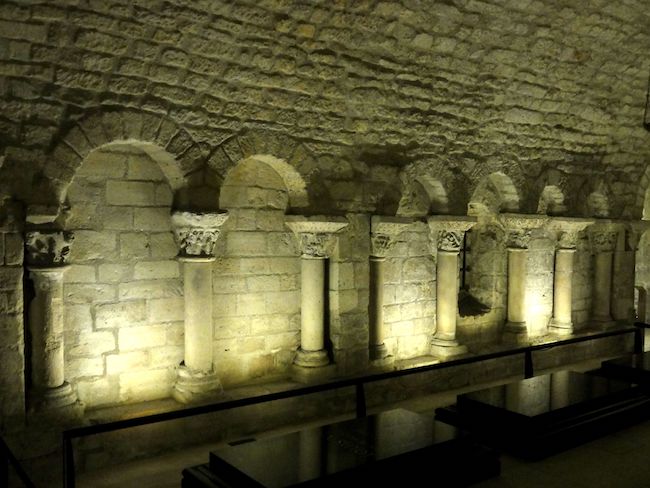
Walls of the crypt built by the Abbot Hilduin. @ CC BY-SA 3.0
What, particularly, to look out for? Certainly the effigy of Louis IX, described by a chronicler as “the most beautiful tomb in the world” and also the dramatic two-tiered marble monument to Henri II and Catherine de’ Medici. Designed as a classical temple, their two shrouded bodies, sculpted in white marble, lie on the lower level, while above are two black marble statues depicting them kneeling in prayer.
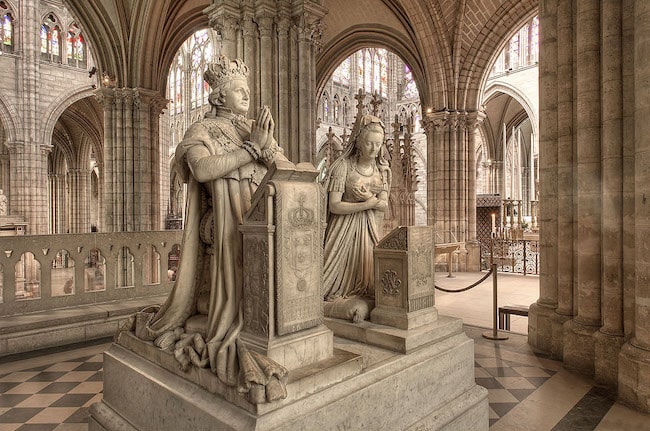
Memorial to King Louis XVI and Queen Marie Antoinette. @ CC BY-SA 2.5
Perhaps the most visited statues are those of Louis XVI and his queen Marie Antoinette, two life-size figures set in their own little chapel, the horrors of their execution behind them and their dignity restored. More controversial is the nearby display, set back into the wall, of the mummified heart of their son, the 10-year-old dauphin Louis Charles, thought to have died of tuberculosis not long after his parents. As recently as 2003 DNA tests analyzing it alongside a lock of hair from Marie Antoinette proved its authenticity.
The first church on this site was built after the martyrdom of Saint Denis in about AD 260, so the cathedral today represents nearly 2,000 years of French history. It stands less than a five-minute walk from the metro station Basilique de Saint Denis on Line 13 and yet it attracts nothing like the visitor numbers of Notre Dame. So if you go, you can enjoy the beauty, the peace and the long sense of history without battling the crowds. A perfect visit at any time, but perhaps especially so for the post-pandemic era.
For more information about the Basilique Saint-Denis, including opening hours and guided tours, visit the official website.
Lead photo credit : Saint Denis Basilique. @ CC BY-SA 4.0
More in church, French kings, history, marie antoinette, monuments, Paris, statue



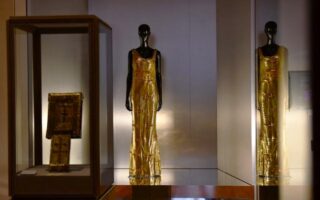
REPLY
REPLY
REPLY
REPLY